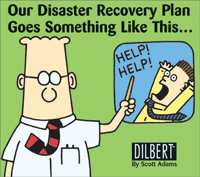
Ever have one of those “oh sh^%!” moments when your data gets deleted or your hard disk spins out of control and takes all your data with it? We have all been there and it’s a painful moment. Sadly, it doesn’t have to be since it’s completely avoidable if we were just more proactive. I had my first oh shit! moment back in 2003 when my iMac went all wonky and I thought I had lost all my data. Luckily I was able to hook it up to another Mac and transfer the data safely to an external hard disk (thank God for target disk mode on Mac’s). That’s when I realized the benefits of running regular backups.
For me there are 3 “oh shit!” moments you are trying to protect against:
- Oh shit! I deleted a file (file diversity)
- Oh shit! my computer hard disk crashed (hardware diversity)
- Oh shit! everything got stolen (location diversity)
The first event is very simple to implement on a Mac, you just have to fire up Time Machine and attach an external hard disk. Then it will periodically backup all your files and keep track of the files you change and allow you to recover to a previous file for whatever reason. Apple makes it even easier with a Time Capsule (a wireless router + hard disk) which continuously backs up your computer over a wi-fi connection to the Time Capsule…pure genius.
Many people forget about event number two because they feel it’s covered by event number one, which is not totally true. If your hard disk crashes you might have all your data on an external hard disk, but you still have to waste hours re-install your operating system, reload your applications and copy your data. That’s a major pain if it happens on a Monday morning and you have a big presentation later in the day. To cover event number two I use Carbon Copy Cloner (CCC), it allows me to make a bootable backup of my computer to an external hard disk. Which means if anything happens to my main hard disk, I can just plug in the external hard disk and boot-up as if nothing happened. It’s become a Sunday ritual to use CCC and make a bootable image to an external hard disk. Oh, and the best part is that CCC is completely free.
Event number three is where I still struggle to have a completely fool proof system. Before the dawn of cloud computing people used to have a multi off-site strategy, they would store copies of their data at their house, office and bank locker. If an earthquake were to hit then most likely all your local data storage locations would have been affected and thus making the strategy useless. But now you can easily backup your data to a cloud service like Dropbox, CrashPlan or Jungle Disk. I use Dropbox for my critical data and it’s great. But, I haven’t gone down the path of backing up all my data which is around 400GB and growing by 1GB a week. To transfer that over a 1MB line would be impractical and not to mention very expensive. In the meantime, I’m still searching for a complete full proof way to insure against event number three.
Well there you have it, a quick summary of how to avoid those three “oh shit!” moments. Since external hard disks are so cheap these days, I would say get two external units and starting backing up right now to avoid events one and two from happening to you. Granted all the information was Apple specific but I’m pretty sure the same can be implemented on the Windoze platform.


External raid 5, e-sata or usb enclosure. Relatively inexpensive but I still keep a copy of critical data.
Well, for far larger back ups than what dropbox can do — and without leaving your whole account open for hours as happened a couple days ago — don’t forget s3 http://goo.gl/ailE . way less expensive, although you might have to pop up a terminal and ssh your tons of gb into the cloud. if you’re into programming ec2 can do a bunch of things with with your data on s3 and you can even create a few nodes from a super computer through elastic map reduce to bombard your data with parallel code
Why is your data growing at 1GB/week? I find my data growth to be far less than it used to be, with lots more streaming and uploading direct to sites rather than hard disk
It’s growing mainly because of torrents (30 Rock, How I Met, Modern Family, etc…)